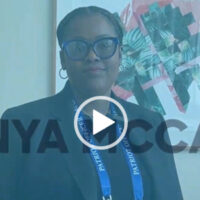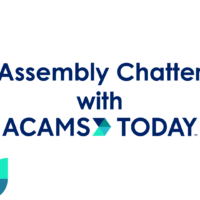
ACAMS Today spoke with Matt Richardson about anti-human trafficking (HT) efforts and the future of HT, his participation in “Dark Highway” (an HT documentary that is being televised in Canada and the U.S.) and the different methods for maximizing online safety. Richardson is director of Intelligence and Investigations with the Anti-Human Trafficking Intelligence Initiative (ATII). He also participates as an international speaker and expert on open-source intelligence (OSINT) and dark web intelligence with extensive experience in leading and coordinating large-scale complex investigations on sex trafficking and child sexual exploitation. In addition, Richardson co-authored a study titled “Expert Analysis of Open-Source Material Relating to Child Sexual Abuse Material and Sex Trafficking Occurring on OnlyFans.com” with the University of New Haven’s Center for Forensic Investigations of Trafficking in Persons (CFITP). He is a member of the Rogers Communications Cybersecurity Catalyst team, where he collaborates with industry experts to generate products and education on a variety of cybersecurity topics related to online crimes. He is often sought out as a subject-matter expert by the media with TV, film, radio and print coverage in Canada. He also works in partnership with Timea’s Cause to educate and prevent sex trafficking and was a featured speaker in the first Canadian National Summit on Child Sexual Exploitation. Richardson is passionate in his role with the ATII, where he is a part of a team of experts that use their skills daily to help make children and families safe and communities safer places.
ACAMS Today (AT): How did you get involved with the areas of internet safety, HT and the prevention of online exploitation?
Matt Richardson (MR): The answer is rather simple: I became a father. I have been blessed with two lovely boys who remind me, literally every single day, just how special children are. As an 80s child of the “Stranger Danger” era, I recall the pictures of children on the missing person posters and milk cartons. I remember the fear (and hysteria) around stranger child abductions and how my parents struggled to teach me about stranger danger in a nonfrightening way. When I became a father and my son began to grow, I struggled with the same question. It was this that led me to study OSINT and dark net investigations. This became the foundation of my safety education sessions (and later investigations themselves) as I designed innovative and age-appropriate lessons on personal safety that reflect the realities of safety risks, both online and offline. In 2020, I was recruited into the child exploitation investigations space, where on a daily basis, I use my skills to help law enforcement (LE) identify and apprehend anonymous child predators and sex traffickers. My love for children truly leads me to my life’s calling and for that, I could not be more grateful or happy.
AT: What are your responsibilities as director of Intelligence and Child Safety with the ATII? What does a typical workday look like for you?
MR: My specializations are OSINT and dark web investigations on child sex offenders and traffickers. My role includes gathering intelligence on forums and communities and the predators that operate within them to support LE investigations and/or generate investigative leads. In addition, I provide typologies on predator behaviors and demographics and observations on the “cultural” nuances of offender “communities.” I find and infiltrate online spaces frequented by offenders that LE can target for investigations. I also help in the planning and coordination of investigations, including consulting with LE and nongovernmental organization partners and ensuring that the appropriate resources are in place. More recently, I have been tasked with building out the ATII Child Safety division, which will strive to help prevent exploitation through education and strategic partnerships in the public and private sectors. A day in my life—my day-to-day—is rarely dull or mundane! My life is a constant balancing act, pivoting between getting my children fed and off to school, delivering lectures and teaching, on-camera appearances (e.g., podcasts and interviews) and working investigations, including planning and briefing calls with some of the finest people and agencies on the planet.
AT: What new trends do you see developing in the areas of HT and online exploitation, and what is driving them?
MR: There certainly have been changes with the COVID-19 pandemic, largely attributed to an increased reliance on technology for much of how we live our lives. Children and teens have been online with far less supervision at unprecedented levels, and with that came increased access to our children and, thereby, increased opportunities for predators.
One specific trend is a rise in “self-generated” child sexual abuse material (CSAM), which is when minors directly generate illicit content of themselves. Although the material is generated by minors, it is most often after being groomed and coerced by predators. The nature of the content should not be mistaken as kids experimenting nor assumed to be “vanilla;” there is a scale for severity and much of the content discovered has been considered “sadistic” and/or degrading. What is also worrisome is that if left unabated, the content typically escalates over time in terms of its frequency and severity, usually in the direction of a predator.
Sextortion (like extortion) is the coercion of a person to produce sexual content so that they may be extorted for sexual gratification and/or financial gain. Since the COVID-19 pandemic, and especially in 2022, there has been a substantial uptick in reported sextortion schemes, more specifically, schemes targeting teenage boys. The scam typically involves a fraudster masquerading as an attractive young female who solicits nudes from the male target. Upon receipt of the content, the fraudster blackmails them by threatening to publicly shame the target by posting the content publicly and sharing it with family and friends unless a sum of money is wired to them. Tragically, a growing number of these cases result in teen victims committing suicide.
AT: Are there any particular projects from throughout your career of which you are particularly proud?
MR: Of the many projects I have been fortunate enough to be a part of, I would have to go with a research report on an online “content creator” platform—Onlyfans—that I co-authored. During the research phase, we uncovered strong evidence at a large scale of sex trafficking taking place and CSAM being produced and hosted on the platform. This project was fascinating as it brought me out of my typical investigative environments and into a space where these crimes were taking place largely out in the open and not in the shadows of the dark web. It was also a very sad thing for me. I am used to being exposed to absolutely horrible crimes and the egregious offenders that commit them, but this was the first time that I became very familiar with victims. Seeing the victims in a far more personal light than I am accustomed to and the shades of their personalities was difficult for me. That said, our work resulted in a report that was entered into Congressional record, resulted in a number of high-level meetings with the platform’s leadership and regulators, created relationships and partnerships and leads reported to LE for investigation and to the platform so the profiles could be removed.
AT: Could you tell us a bit about your participation in the documentary “Dark Highway?”
MR: My experience on the “Dark Highway” film has been fantastic! I will never forget the day that my home became a movie set for a day! It was a fascinating and fun experience being on camera and the “star” for a day. I was discovered and recruited online by the producers, who, at the conclusion of our interview, sent me a contract to join the production. My role has included being an on-camera “character,” providing subject-matter advice on sex trafficking and sexual exploitation and generating products, such as the film’s “heat density map,” which gives viewers a visual of sex trafficking activity along highway 401 in southern Ontario. Highway 401 is one of the busiest highways in North America, with a number of large urban centers connected by it. Yet, so many, including those living along highway 401, remain oblivious to the reality that HT is happening everywhere, including in small and rural communities. That is one reason I feel that the film tells an important and timely story, and its esteemed collection of survivors and experts informs the narrative in such a way that it provides much humanity to the crime, as well as people, and it is both factually true and relatable to the general public.
AT: As a proponent of online safety, what advice would you give readers regarding what they can do to ensure their online safety?
MR: As adults, we may make the mistake of thinking safety does not apply to us, but it does. People of all ages and backgrounds are targets of predatory actors. As adults, we may ourselves become the target of a predator. Even if we feel that we are not directly at risk, we may not be the “direct” target and could be the “in” to gain access to women and/or children in your life. We do not want to be the weak link and expose our loved ones to risk!
It is astonishing to think about the risks we are willing to take online that we never would offline. We would never share personal details about our lives or photos with a stranger on the street, so why are we doing so online? Limiting how much we share about ourselves and our families online is one simple step to enhance our safety.
Know and be able to recognize the signs of troubling behaviors such as grooming (often a process of seduction or that is “too good to be true”), gaslighting (when someone makes us doubt ourselves or feel bad about asking reasonable questions) and love bombing (when someone falls too hard and too fast for you). We need to think critically about new relationships. I abide by a “trust but verify” philosophy to vet new contacts. I recommend validating information about someone new (especially prospective romantic partners) by searching them online before admitting them into your personal or professional life.
Interviewed by: Karla Monterrosa-Yancey, CAMS, editor-in-chief, ACAMS, USA, kmonterrosa@acams.org
Ben Bahner, editor, ACAMS, USA, bbahner@acams.org










